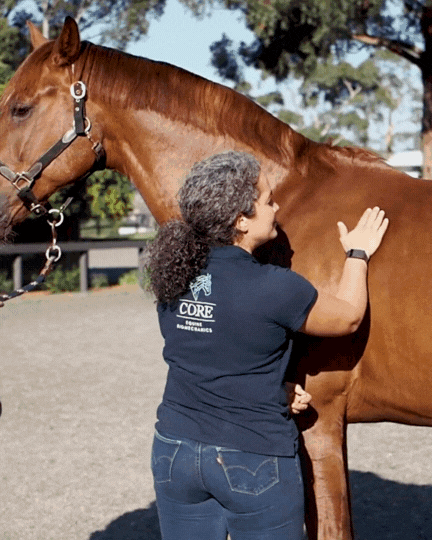Equine Core Activation and How to do an Effective Belly Lift
- Anushka von Oppen

- May 26
- 3 min read
Updated: Jul 11
How to Help your Horses Engage their Core
One of the most common challenges I see in practice — particularly when managing back discomfort or retraining posture — is helping horses engage their core. Riders often focus on the topline, but without activation of the deep abdominal muscles, the spine lacks the stability it needs to support ridden work, especially under load.
The belly lift is a simple, hands-on technique I regularly recommend to clients. When performed correctly, it activates the deep postural muscles that support the spine from below, helping improve posture, balance, and back strength. It’s a valuable tool not only in rehabilitation, but also in conditioning programs for performance horses.
What Is the Belly Lift?

The belly lift is a physical cue applied along the midline to the sternum of your horse’s abdomen using gentle upward pressure. When performed correctly, the horse will reflexively contract the abdominal muscles and slightly lift the back. This mimics the engagement needed for collection, lifting through the thoracolumbar spine, and improved postural control.
You might notice:
Slight lifting of the back between the withers and loins
Tightening of the abdominal wall
Gentle flexion of the lumbosacral area
These are all signs of core engagement.
Why Does Abdominal Activation Matter?
The horse’s core includes the deep stabilising muscles that support the spine, pelvis, and ribcage.
By activating these muscles through belly lifts (and other dynamic mobilisation work), you’re helping your horse build:
A stronger, more stable back through activation of the spinal stabilisers
Improved posture
Enhanced ability to carry weight (including the rider)
Better coordination, especially in lateral and collected work
When Should You Use This Exercise?
Belly lifts can be useful in:
✔️ Rehab programs for back pain, kissing spines, or postural weakness
✔️ Activation prior to work encourage spinal mobility before work
✔️ Strengthening programs in combination with pole work, groundwork or in-hand exercises
They are safe to use on most horses when done gently and consistently — but should not be painful or forced. If your horse resents the lift by kicking out, biting or other defensive behaviours, make sure you consult with your rehab specialist prior to performing more reps.

How To Perform a Belly Lift
Stand beside your horse, near the girth line.
Make sure you are all the way across to midline with you hand when you contact the belly. One of the most common mistakes I see is people placing their fingers to the side of the midline.
Starting mid-abdomen, use gentle, consistent upward pressure with your fingertips and gradually run forward towards the sternum. This can be done with a gentle tickle or rub of the hair, as you move forward. This stimulates the hair follicles and assists in the lift.
You should see the belly lift and the back rise.
Hold for 3-5 seconds.
Repeat 3–5 times once daily, ideally before a working session to get those abdominals firing and switched on.
Tip: The lift should be slow and smooth — avoid jabbing or sudden movements.
What Good Form Looks Like
Subtle lift through the topline
No tail swishing, tension, or moving away
Symmetrical abdominal contraction
Calm, relaxed response
If your horse reacts defensively or unevenly, this could indicate underlying discomfort — and we recommend assessment before continuing.
When to Avoid
❌ Immediately post-surgery or during acute abdominal pain
❌ If your horse has significant girth sensitivity or ulcer concerns (until cleared)
❌ If your horse shows pain or flinching — this should be explored further
Summary
Belly lifts are a simple but powerful tool for building your horse’s postural strength. When used consistently (minimum 3 x per week), they help improve spinal support, encourage correct movement patterns, and play a valuable role in long-term soundness and performance.
As always, contact us if you’re unsure whether your horse is a candidate for these exercises or would like a customised plan from an experience chiro horse vet in Melbourne.






Comments